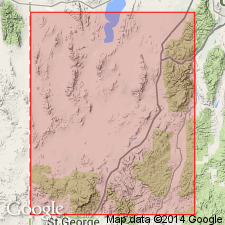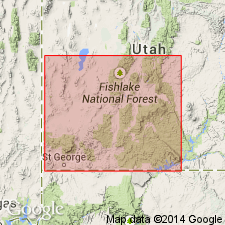
- Usage in publication:
-
- Kane Point tuff [member]
- Modifications:
-
- Named
- Dominant lithology:
-
- Tuff
- AAPG geologic province:
-
- Great Basin province
Summary:
Named as the upper [member] of the Page Ranch formation, a unit known in the Page Ranch quad, Washington and Iron Cos, UT in the Great Basin province. Named for Kane Point to southwest in Washington[?] Co, UT in the Great Basin province. Type locality not stated. Consists of scarp-forming vitric ignimbrite of rhyolitic composition. Thickness not stated. Overlies the newly named Irontown member of the Page Ranch. Oligocene-Miocene age.
Source: GNU records (USGS DDS-6; Denver GNULEX).

- Usage in publication:
-
- Kane Point Tuff Member†
- Modifications:
-
- Abandoned
Summary:
Kane Point Tuff Member of Page Ranch Formation abandoned in favor of Racer Canyon Tuff. Page Ranch is restricted to rocks below Racer Canyon (former Kane Point) and above Rancher Formation. Rancher has an isotopic age of 19 m.y.
Source: GNU records (USGS DDS-6; Denver GNULEX).
For more information, please contact Nancy Stamm, Geologic Names Committee Secretary.
Asterisk (*) indicates published by U.S. Geological Survey authors.
"No current usage" (†) implies that a name has been abandoned or has fallen into disuse. Former usage and, if known, replacement name given in parentheses ( ).
Slash (/) indicates name conflicts with nomenclatural guidelines (CSN, 1933; ACSN, 1961, 1970; NACSN, 1983, 2005, 2021). May be explained within brackets ([ ]).

